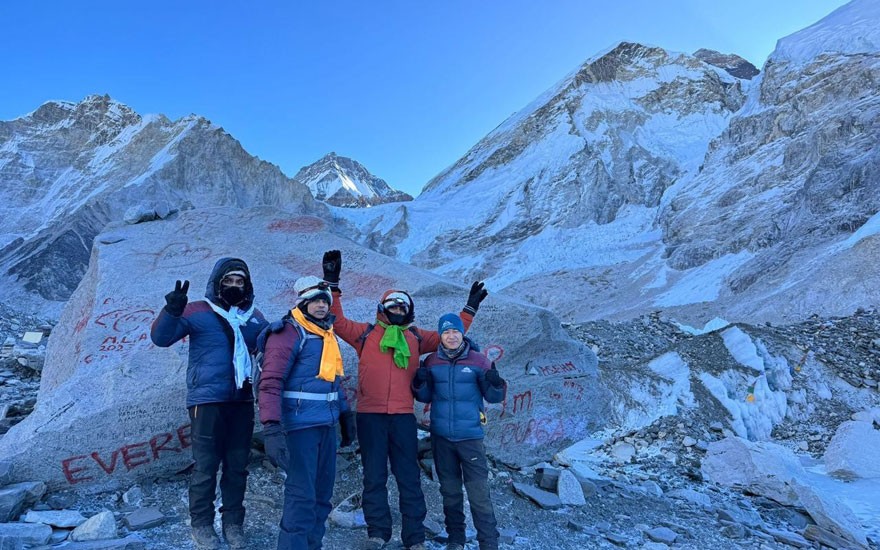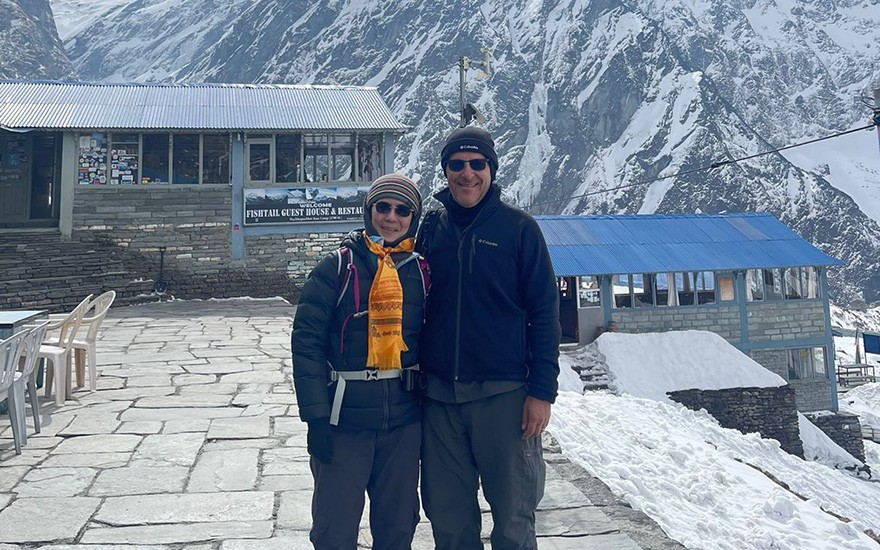
Trekking in Nepal
By Alpine

Altitude Sickness and Importance of Acclimatization on the Everest Base Camp Trek
Trekking to the base camp of the world’s highest mountain is not an easy feat. There are a lot of things to be considered and followed to ensure an enjoyable, successful, and safe trek. Apart from making a proper packing list and training for the Everest Base Camp Trek, having the knowledge on altitude sickness and acclimatization is essential. So let’s take a moment to understand both of these topics.
What is altitude sickness?
Altitude sickness is a medical condition that happens when your body experiences a lack of oxygen when you climb to higher elevations faster than your body can adjust to the change in the atmosphere and level of oxygen. The higher the altitude, the lower the oxygen level.
Is altitude sickness common?
It is one of the most common illnesses experienced by trekkers and mountaineers, especially those who are not acclimatized to the high altitude properly. People usually start experiencing altitude sickness once they reach 2500 meters or 8000 feet above sea level. Ascending quickly in a single day will assure altitude sickness.
One is more susceptible to altitude sickness if they ascend 1000 meters in a single day above 2500 meters. Therefore, it is only recommended to ascend 300 meters to 500 meters per day.
What are the stages of altitude sickness?
There are three stages of altitude sickness
Acute Mountain Sickness (AMS)
It is the most common stage and has mild symptoms such as headache accompanied by dizziness, fatigue, nausea, loss of appetite, or, occasionally, vomiting. Usually, the illness is self-limited, taking one to three days to develop and clear up. The symptoms lasting more than three days without any further ascent should not be considered as AMS.
High Altitude Cerebral Edema (HACE)
High-Altitude Cerebral Edema or HACE, is a life-threatening form of altitude sickness that is considered the end stage of AMS. With low oxygen levels, it causes a negative reaction on the brain, which results in the swelling of the brain. HACE frequently manifests as disorientation, fatigue, weakness, and trouble in hand-eye coordination.
High Altitude Pulmonary Edema (HAPE)
High-Altitude Pulmonary Edema can happen on its own or can be a worsened stage of the AMS. It is a condition where fluids accumulate in the lungs, which is potentially more fatal than HACE. Chest congestion, coughing up pink, foamy sputum frequently, increased dyspnea upon exertion, and reduced exercise performance are all signs of HAPE.
Avoiding Altitude Sickness during the Everest Base Camp Trek
Trekking to Everest Base Camp comes with its own set of challenges. But these challenges can be overcome by following the right instructions. One of the most common experiences for people who are avid trekkers at the high elevations is altitude sickness. While there are medications you can take to ensure not getting altitude sickness, the best way to avoid getting altitude sickness is by doing proper acclimatization. Let’s discuss further on the topic of acclimatization.

What is acclimatization?
Acclimatization is the process of letting your body adjust to the lower level of oxygen at the higher altitudes to avoid altitude sickness. Because once you cross over the altitude range of 2500 meters, the level of oxygen in the atmosphere starts to decrease; the higher you go, the lesser the oxygen. Therefore, ascending very quickly does not allow our body to adapt to the lower oxygen, which in turn causes mountain sickness such as AMS, HACE, and HAPE.
Trekking is an activity that requires a lot of physical energy and stamina, as you will be walking for hours a day, and combined with a strain of low oxygen, it is crucial to let your body adjust to the altitude by proper acclimatization for a better trekking experience during the Everest Base Camp Trek.

What is the importance of acclimatization during trekking to Everest Base Camp?
Acclimatization is something that should be practiced from the very beginning of this trek. As the trek to the Everest Base Camp begins from Lukla, which is at an elevation of 2,860 meters (9,383 feet) above sea level, you are already at a zone where the chance of getting altitude sickness is possible, and it increases as you ascend higher. Here is why it is important to acclimatize while trekking:
A preventive measure for altitude sickness
As we previously discussed, altitude sickness can manifest in different forms, such as acute mountain sickness (AMS), high-altitude cerebral edema (HACE), and high-altitude pulmonary edema (HAPE), if our body hasn’t adapted to the high elevation. Therefore, acclimatization ensures your body adjusts well to the high altitude and low oxygen, preventing you from suffering from altitude sickness.
Staying an extra day at Namche Bazaar and Dingboche to acclimatize should be standard on your itinerary. This will help your body to adjust better and prevent the altitude sickness altogether or at the very least will not let your symptoms worsen.
Physiological Changes
The higher you go, the physiology of your body changes due to the change in the environment, namely the decrease in oxygen level from the atmosphere. Thus, it takes your body more energy than usual to function, which can feel quite taxing. Your body initially has to produce more red blood cells in order to maximize the oxygen in your body, which leads to an increase in breathing rate and heart rate.
Acclimatization helps in getting the body needed time and rest to adjust, which in turn will improve the quality of your health and overall trekking experience.
A successful trek and benefits
Acclimatization helps in reducing anxiety and stress along with optimizing your physical health, which helps to ensure the best trekking experience during your trek to the Everest Base Camp. It also plays an important part in being able to withstand more pressure as you ascend higher, which increases your stamina and overall performance by lowering your chance of getting altitude sickness.
What are the steps for acclimatization?
There are several steps that you should thoroughly follow to avoid altitude sickness as a part of acclimatization and they are listed below:
Should I take medication for altitude sickness during the Everest Base Camp Trek?
There are few medicines that are said to help with altitude sickness. Acetazolamide (Diamox) is commonly used by people but should be taken under the prescription of your physician. It can help aid your acclimatization and should not be used as a substitute for it. You should also be aware of the side effects of these medications and do a test run before using them during the trek.
For common symptoms such as headache and nausea, a simple paracetamol should be enough. Apart from that, you should only take the medication after consulting an expert. Once again, medications should not be used as a replacement for acclimatization.
Descend, Descend, Descend!
No matter what medication you take, the most effective way to minimize the symptoms of altitude sickness is to descend down immediately. Acclimatizing, of course, is a crucial step of trekking to the Everest Base Camp, but if your symptoms of altitude sickness do not seem to get better, descend down as soon as possible, preferably from 300 meters to 1000 meters depending on the severity of the sickness.
In cases of emergency descent, you should have insurance that covers Heli Rescue, which is the fastest way to lose elevation and get urgent medical care.
In conclusion,
Altitude sickness is the result of poor acclimatization and not letting the body adjust to the change in the environment around you as you ascend higher, especially with a lower level of oxygen. Acclimatization not only helps to avoid worsening of the AMS but also enhances your overall trekking experience.
Acclimatization helps to keep your physical and mental well-being in check and helps to enjoy your trek to the fullest. Always keep an eye out for the symptoms of AMS and act quickly; prevention is better than cure. Listen to your body and descend if the symptoms do not get any better over time.
Take days out of your itinerary to acclimatize and complete the entire trek successfully without any trouble. If you are looking to trek to the Everest Base Camp with the best itinerary that focuses on acclimatization and ensuring your best time, then we have just the package for you. For more details, contact us via WhatsApp at +977 985-1175531 or email us at alpineramble@gmail.com